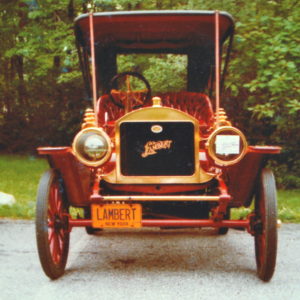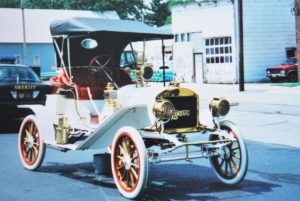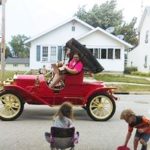Here is the Evidence that Proved John William Lambert Invented America’s First Gasoline Automobile
There are several pieces of evidence that Antique Automobile Editor L. Scott Bailey had to determine John Lambert’s 1891 vehicle was the first gasoline powered car in America. These important historical documents are held by the Smithsonian Institution.
- the photograph taken by Van Wert photographer Walter Lewis and his sworn statement with the time and date, August 1891.
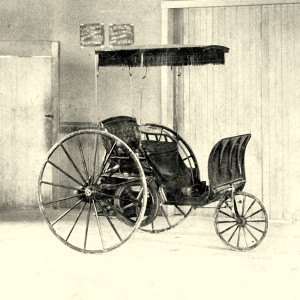
- the affidavit by James Swoveland swearing he rode in that car in 1891, the entire text of his statement follows:
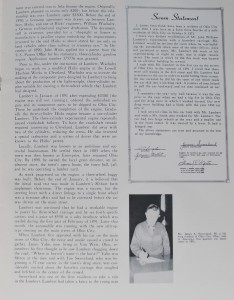
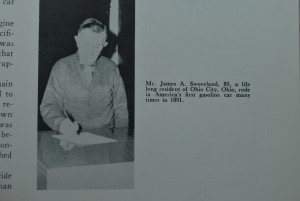 This picture of James Swoveland is with the Lambert article in Antique Automobile. It says, “Mr. James A. Swoveland, 89, a lifelong resident of Ohio City, Ohio, rode in America’s first gasoline car many times in 1891.”
This picture of James Swoveland is with the Lambert article in Antique Automobile. It says, “Mr. James A. Swoveland, 89, a lifelong resident of Ohio City, Ohio, rode in America’s first gasoline car many times in 1891.”
Swoveland Statement
I, James Swoveland, have been a resident of Ohio City since 1884. I was born on a farm three-fourths of a mile southeast of Ohio City on October 9, 1871.
I have very distinct recollections of Mr. John William Lambert’s experiments with a horseless carriage. Mr. Lambert would let me into the room where he was building the automobile when most of the other fellows were not permitted to enter. Mr. Lambert did much of his experimenting at night in order that it might remain secret. The room in which he did this work was located in an elevator building he owned.
I rode with Mr. Lambert in this first car on the streets of Ohio City in the summer of 1891. I recall that there were still stumps in the dirt street and Mr. Lambert had to maneuver the car in order to avoid hitting those stumps. On one occasion he did hit the roots of one which made the car skid into a hitching rack. A number of men helped us pull the car backward and we then continued on our way.
I remember the year very well because it was the one prior to the year when we had a big fire in Ohio City and the drug store in which I worked burned. Our new drug store building had a block with the year 1892 cut into it.
I took several rides in this car both with Mr. Lambert and a Mr. Smith who worked for Mr. Lambert. The car had two large wheels at the rear and a smaller one in the front center. It was steered by a lever. It had a fringed top.
The above statements are true and accurate to the best of my knowledge.
-Signed by two witnesses, Mr. Swoveland and Truman Martin, Notary Public, February 9, 1960.
- the list of pertinent questions answered in John’s own handwriting, transcribed in full here:
Ray’s List of Questions (I have typed what I see written on the pages. I am not sure of the order of the pages and have indicated page breaks only. Ray, John’s son and my grandfather, has typed out the questions, leaving space on the page for his father to answer. John, in his own hand, has written answers.)
Did you build a gasoline engine prior to building the original automobile? No.
If not, how or why did you conceive of an automobile prior to a gas or gasoline engine? I Built the gasoline for the Horseless Carriage First Stationary afterwards
What was your first experience with gasoline engines? The first Stationary Gasoline Engine 1892
Since no automobile had been built in this country prior to 1891 give the circumstances surrounding its inception. I saw a Picture of a Horseless Carriage made in Urope by the Bentz Co
What was your original conception of an engine for a “horseless carriage”? It must be of Light weight and 4 cycle
Who and what was the Ohio Gas Cycle Company? A name only – not used.
Where was the machine work done on this car? Most of it was done by Lowell machine Co. at Cleveland, Ohio
Give a general description of the construction of this car. The car was of 3 wheels and a 3 cylinder Eng 3 ½” x 4”
Was a differential used? Yes in the axel
What was the final drive? chains
Some attempts had been made abroad on the automobile but this car seems to have more delicate lines than the cumbersome ones built abroad. What, in your opinion, brought this about? The Bentz car was “Belt-drive
What kind of bearings were in the wheels? wheel was key to axels
Did you ever build another three wheeled car? no
Was there anything in your experience with this first one that caused you to eliminate this idea? Lots of things. I had many upsets with the 3 wheels
How did you control the throttle? with a Hand Leavor
What was the maximum speed of the vehicle? 15 miles Pr Hr
What provision was made for going in reverse? none
Why did you not follow this car immediately with others? too Early in the game & went to stationary Engines
When did you leave Ohio City? 1892
When did you start in the gas engine business? fall of 1892
Was it prior to the time that you started building poles and shafts? Yes (this question is lined out)
Did you build complete poles and shafts at Union City? No
* * * * * *
When did you start building buggies in Anderson after moving there in 1893? (John put a 4 over the 3)
Do you remember when you bought the car from Oscar Lear at Columbus, and what were the circumstances surrounding it? 1899 – motor was 3 teeth out of time. Lear never made this car run. Elgin
What are the names of the men now living who remember this first automobile? (impossible to read, maybe) Bill Sayler
The important thing is to recall why you conceived of the idea of a “horseless carriage” and for what reason did you proceed to build it at this early period? saw first otto slide valve coal gas engine at Greenville after fire at tannery. His father saw it run. 1876
There must have been some available information on the subject, either from here or abroad. Yes – Benz came to my attention – Belt drive
Give as much detail as possible relative to the design of the transmission. Chains to countershaft – 2 speeds – no reverse – 1 chain to axle which was gripped with back gear differential.
Do you remember your first meeting with Chas. Duryea? At times Herald race. was an official at the race.
You also knew Frank Duryea, who built the Stevens Duryea, a very modern car, at the time that Chas. Duryea was, I believe, still building a three wheeled job – yes. with four wheels only as optional. It is important that answers to a question like this be very much deliberated upon so that dates are relatively accurate. Daimler(complicated) could not figure out
When did you build the first carburetor?
Prior to this time what was used to mix the air and gasoline? Daimler had a little boat engine in Ny with a complicated mechanism to pull air thru gasoline. I saw this in New York
Was this a two or four cycle motor? 4
What was your reason for selecting the type used? Sintz Gas Eng Co. of Springfield built a 2 cycle Believed in Otto 4 cycle principle.
Where had you had your first gas engine experience? In ohio –
Were gas engines being built in this country, beyond this experimental stage? On verge of experimental.
What materials were used for the crank shaft, connecting rod and the piston, and what type of bearings were used? In the auto – cold roll & malleable crank size 1 ¼ di? – Babbit bearings – malleable con rods.
Was this air or water cooled? Water
If water cooled, was it thermosiphon or was a pump used, and what was used for a radiator? (John underlined thermosiphon) about a 3 gallon water tank capped with steam vent.
Was this machine originally designed as a single cylinder job or as a multiple cylinder? Multiple 3 cyl.
If multiple, how many cylinders were contemplated, and why? (John crossed out a two word answer)
When did the first evidence of over-production come to your attention, and what was done about it? Haynes was figuring on 75 a year during 1902 or 1903 and when he found out how many JWL intended building he came to him and wanted to make an agreement to cut production.
* * * * * *
When was the Union Automobile Company organized? 1902 or 03
Can you recall the annual production of the Union Automobile Company? about 10 per month
As I recall it, the Union Automobile Company was taken over by the Buckeye in 1904 or ’05. When was the Buckeye sold out to the Pioneer Pole and Shaft?
When was the new gas engine plant built in Anderson? 1904
We finally liquidated the automobile business in 1914, (John wrote a 5 over the 4, making the date 1915) as I remember, with 1907, “08, ’09 and “10 standing out as maximum production years in my mind. Give as accurate information as possible as to the production figures during these years. Glad King no doubt could help us in this. Approx. 2000 cars per year.
Give a resume of the original gear driven machines and your reason for shifting to friction drive.
What patents were obtained on the friction drive, and because of what fundamental reasons were they obtained?
I remember the Hennigan carburetor. (John wrote St. Louis) What were the circumstances surrounding this? It seems to me that it had a great deal to do with our developing the early cars which preceded the Union automobile. It seems to me that we did not have a float chamber in these Hennigan carburetors, but instead had a mixing chamber in the intake manifold and a governing device thereon. OK.
What was your early belief regarding mounting a motor transmission directly on the axles or with the body on springs? Everything on springs
What was your early conception regarding the pushing (John crossed out pushing and wrote placing) of the motor independent of the main frame and body? See patent.
Were there any patents issued on this, and when? yes.
Were there any patents applications or patents issued on the first automobile, and what did they involve? yes on vaporizer.
What was the name of the first purchasing agent in Union City? Where did we get him and who did he go with later?
Did Chas. Duryea ever make claims as to having built the first automobile in America prior to recent years? not to my knowledge. He went to Ohio City and found I had built it.
It seems to me that Elwood Haynes made these claims, and that you permitted him to make them because of some certain specific friendship or because of the fact that you felt you were doing him a business and personal favor. As I remember it, they battle used to be between Ackerson and Haynes as to who built the first car, they both having worked on it together, according to my memory. John crossed out Ackerson and wrote Apperson
I have a notation here of letters of inquiry which I have seen and upon which I have noted dates in an old notebook, from people whom I believe later became interest in the automobile business.
* * * * * *
A letter from D.S. Marsh, South Bend, Indiana, dated February 25, 1891.
A letter from Case Buggy Company, Muncie, Indiana, dated February 26, 1891.
A letter from Boyd and Freed at Melrose, Ohio, signed by Mr. Mooney, dated March 4, 1891.
A letter from Cook Carriage Company, Cincinnati, Ohio, signed by Maurice S. Shipley, Sec., dated February 25, 1891.
A letter from the Parry Manufacturing Company, signed by D. M. Parry, Pres., dated February 15, 1891.
A letter from J. E. Just, Iona County Savings Bank, Iona, Michigan, and a letter from the Flint Road Cart Company, signed by Mr. Dort, of approximately the same date, together with some other names which are on my list, or letters which I have seen.
This car must have been finished and had some publicity prior to February, 1891, which must have been the reason for your having received these inquiries. In reading these letters, there were inquiries asking for further information. The gist of all these letters seems to be about the same – Will this car run? I remember having seen some of the original pamphlets put out on this car. Was this pamphlet printed because of these inquiries, or was it printed for some other reason? Printed for distribution thru my mail and my brothers mail.
I have a notation of the first stationary gas engine built May 19, 1892. by you – Built at Van Wert Machine Co – has vaporizer on it.
I see a carburetor patent, #474838, in my notes. This must have been one of the earliest carburetor patents in existence. What additional information can be had on this?
I remember as a boy your taking me to see a gas engine in operation in the basement of a saloon, and it seems to me that this must have occurred in about 1892. –yes I have heard you talk about the problems of carburetion in connection with this particular engine, which was used for the purpose of making electric lights in this saloon. Averaged about 10 per day average of 15 HP. John crossed out making electric lights and wrote running fans.
Were there any producers of gas engines in the early days that reached out production schedules, let us say up to 1905? What were the competition in those days, in that period from 1893 to 1905, as far as stationary engines were concerned?
When did you first hear of the Diesel engine, and what was your interest in it? It was unnecessary & course we had fuel that was of practically no cost
Why were the Diesel engines so unimportant to us in the oil fields. (John adds where) I remember we sold a lot of our output. Cheap gasoline and distillate

